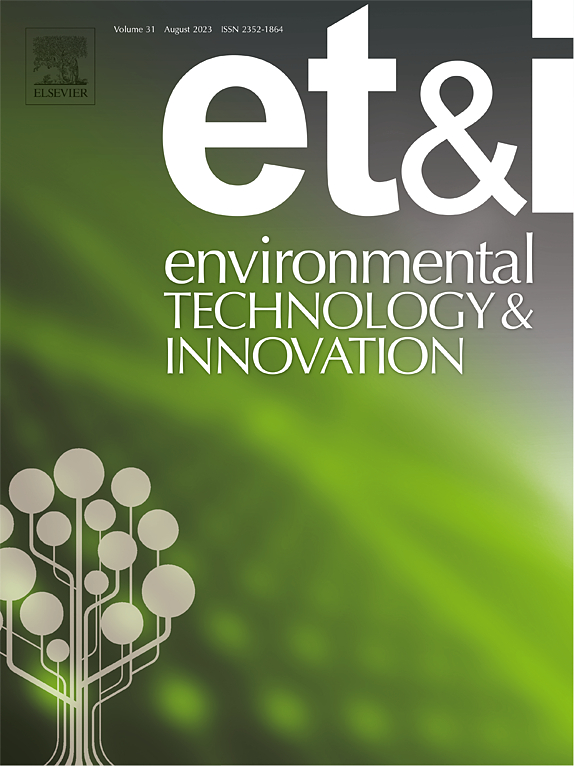IF 6.7
2区 环境科学与生态学
Q1 BIOTECHNOLOGY & APPLIED MICROBIOLOGY
引用次数: 0
摘要
本研究根据循环经济的原则,探讨了如何利用酒精蒸馏的副产品--用完的葡萄渣作为生物吸附剂,去除废水中的镉(II)。水中的镉会对环境和健康造成严重危害。传统的处理方法往往成本高昂且破坏环境。这项研究提出利用农用工业废物作为一种可持续的经济替代方法。采用箱-贝肯设计和响应面方法对生物吸附过程进行了优化,调整了镉浓度、生物吸附剂用量、溶液 pH 值和搅拌时间等因素。研究结果表明,镉(II)的去除率随着搅拌时间的延长而提高,在 134 分钟时达到 99%。最佳条件包括生物吸附剂用量为 2.4 克,pH 值为 4.7,初始镉浓度为 55 毫克/升。生物吸附过程还提高了溶液的 pH 值,确保符合废水排放规定。对两种优化方案进行了评估。第一种方案实现了 99.99% 的去除率,最大程度地减少了镉的排放;第二种方案侧重于成本效益和环境影响,实现了 77.35% 的去除率。这种方案突出强调了减少对环境的影响,从而支持将用完的葡萄渣作为一种可行的、生态友好型的废水处理方案。利用 CML-IA 中点指标和 ReCiPe 终点指标进行的生命周期分析进一步强调了这种方法的可持续性,肯定了葡萄渣在促进循环、资源节约型废水管理方面的潜力。本文章由计算机程序翻译,如有差异,请以英文原文为准。
Eco-efficient cadmium(II) removal from water using alcohol distillate waste: A study of life cycle assessment
This study investigates the use of exhausted grape pomace, a byproduct of alcohol distillation, as a biosorbent for use in removing cadmium(II) from wastewater, in line with principles of a circular economy. Cadmium in water presents substantial environmental and health risks. Conventional treatment methods are often costly and environmentally damaging. This research proposes the use of agro-industrial waste as a sustainable and economical alternative. The biosorption process was optimized with Box-Behnken Design and Response Surface Methodology an adjusting factor such as the cadmium concentration, biosorbent dosage, solution pH, and stirring time. The findings reveal that cadmium(II) removal improves with increased stirring time, reaching a 99 % removal rate at 134 min. Optimal conditions include a biosorbent dosage of 2.4 g, pH 4.7, and initial cadmium concentration of 55 mg/L. The biosorption process also increased the solution’s pH, ensuring compliance with wastewater discharge regulations. Two optimization scenarios were evaluated. One achieved a 99.99 % removal efficiency for maximum cadmium reduction, The second focused on cost-effectiveness and environmental impact, attaining 77.35 % removal. This scenario highlights reduced the environmental impact, thereby supporting the role of exhausted grape pomace as a viable and eco-friendly option for wastewater treatment. Life cycle analysis, using CML-IA mid-point and ReCiPe end-point indicators, further underscores the sustainability of this approach, affirming the potential of grape pomace to contribute to circular, resource-efficient wastewater management.
求助全文
通过发布文献求助,成功后即可免费获取论文全文。
去求助
来源期刊

Environmental Technology & Innovation
Environmental Science-General Environmental Science
CiteScore
14.00
自引率
4.20%
发文量
435
审稿时长
74 days
期刊介绍:
Environmental Technology & Innovation adopts a challenge-oriented approach to solutions by integrating natural sciences to promote a sustainable future. The journal aims to foster the creation and development of innovative products, technologies, and ideas that enhance the environment, with impacts across soil, air, water, and food in rural and urban areas.
As a platform for disseminating scientific evidence for environmental protection and sustainable development, the journal emphasizes fundamental science, methodologies, tools, techniques, and policy considerations. It emphasizes the importance of science and technology in environmental benefits, including smarter, cleaner technologies for environmental protection, more efficient resource processing methods, and the evidence supporting their effectiveness.
 求助内容:
求助内容: 应助结果提醒方式:
应助结果提醒方式:


